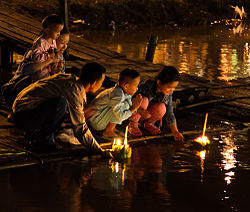Week5
Languages in Thailand
The Thai language is comprised of 44 consonants, 32 vowels and five tones in Thai pronunciation, along with a script that has Indian origins. The Thai language, belonging to the Tai family, is the main language in Thailand although there are several regional dialects as well. Other languages spoken in Thailand are Chinese, Lao, Malay and Mon-Khmer, while English use is becoming more prevalent in government and commerce. English is also being taught as a second language in secondary school and universities, which enables the English speaking visitor in Thailand to have little trouble conversing.

 Thai is the language spoken most often in Thailand; however, you will see English in most businesses and volunteer organizations as well. Numerous apps, phrasebooks, and downloads are available to help even the most inexperienced volunteer learn some basic Thai phrases. Thai people are accustomed to tourists, so do not be afraid to try and speak the language; more often than not they will know what you are trying to say, and will appreciate your effort.
Thai is the language spoken most often in Thailand; however, you will see English in most businesses and volunteer organizations as well. Numerous apps, phrasebooks, and downloads are available to help even the most inexperienced volunteer learn some basic Thai phrases. Thai people are accustomed to tourists, so do not be afraid to try and speak the language; more often than not they will know what you are trying to say, and will appreciate your effort.
The Thai language is comprised of 44 consonants, 32 vowels and five tones in Thai pronunciation, along with a script that has Indian origins. The Thai language, belonging to the Tai family, is the main language in Thailand although there are several regional dialects as well. Other languages spoken in Thailand are Chinese, Lao, Malay and Mon-Khmer, while English use is becoming more prevalent in government and commerce. English is also being taught as a second language in secondary school and universities, which enables the English speaking visitor in Thailand to have little trouble conversing.

 Thai is the language spoken most often in Thailand; however, you will see English in most businesses and volunteer organizations as well. Numerous apps, phrasebooks, and downloads are available to help even the most inexperienced volunteer learn some basic Thai phrases. Thai people are accustomed to tourists, so do not be afraid to try and speak the language; more often than not they will know what you are trying to say, and will appreciate your effort.
Thai is the language spoken most often in Thailand; however, you will see English in most businesses and volunteer organizations as well. Numerous apps, phrasebooks, and downloads are available to help even the most inexperienced volunteer learn some basic Thai phrases. Thai people are accustomed to tourists, so do not be afraid to try and speak the language; more often than not they will know what you are trying to say, and will appreciate your effort.

